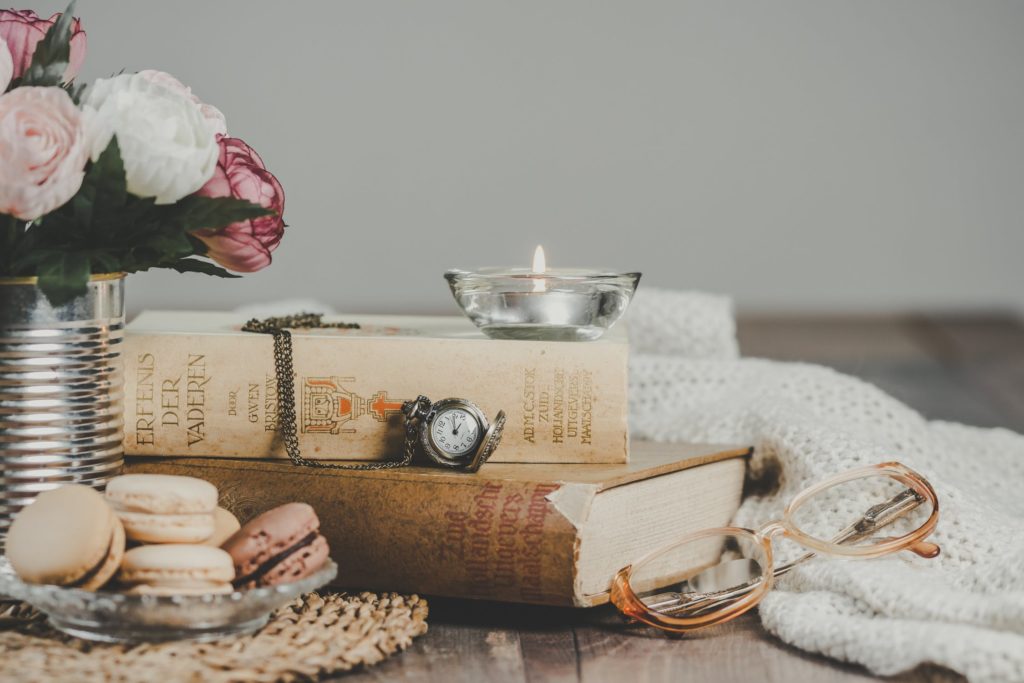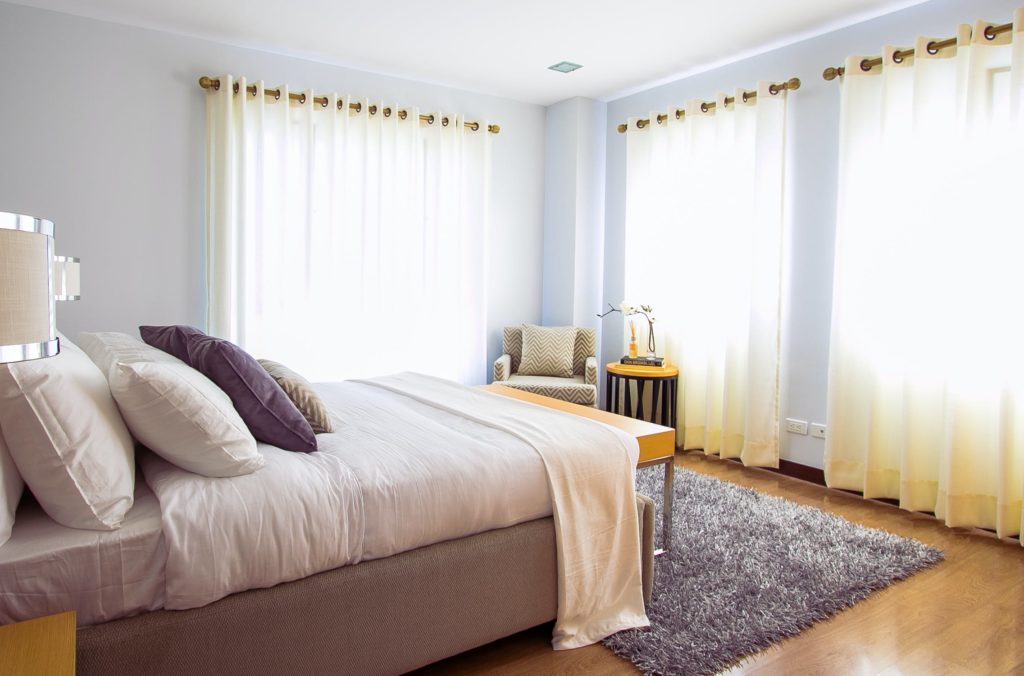There are a few steps people can take to set up their bedroom and create the optimal sleep environment — all backed by science, too! Here’s what the experts recommend.
9 Ways to Make the Best Sleep Environment
Pay Attention to the Temperature
The ambient temperature in your bedroom can play a huge role in how well you sleep. The National Sleep Foundation estimates that the ideal temperature for sleep is 65 degrees, though everyone is slightly different so one’s temperature needs may vary.
AS a result, they recommend keeping the bedroom between 60 and 67 degrees, so people should program their thermostat, set up a fan, or open a window to help them reach that sweet spot. For babies and toddlers, something warmer is needed, closer to 70 degrees.
Note that a room that’s too hot will make you more likely to wake up with the night sweats, and room temperature can also diminish your ability to get deep, restorative sleep. Finally, note that some mattresses (including memory foam ones) trap body heat; it’s important to have a cool room, but also to have a cooling mattress.
Temperature Quick-Guide by Bedroom Size
- For small bedrooms: Adjust your ceiling fan according to the season. Keep curtains closed during the day to keep the sun out. At night, keep your bedroom door open to promote air circulation.
- For large bedrooms: In addition to the tips above, also remember that small box fans can help circulate the air, without adding too much to your cooling bills.
RELATED: What’s the Best Temperature to Sleep In?
Make It as Dark as Possible
Ensure that no distracting light gets into the bedroom at night, whether that’s from street lamps or the moon. People can set up blackout shades or solid drapery, and have a good eye mask on hand as a backup option.
The absence of light is crucial for getting proper rest.
When it gets dark, one’s body releases melatonin — a hormone that helps people feel drowsy. The National Sleep Foundation explains this in more detail:
“Exposure to light stimulates a nerve pathway from the retina in the eye to an area of the brain called the hypothalamus. There, a special center called the suprachiasmatic nucleus (SCN) initiates signals to other parts of the brain that control hormones, body temperature and other functions that play a role in making us feel sleepy or wide awake.”
So, darkness helps cue one’s body that it’s time to go to sleep and stay asleep.
RELATED: 5 Best Sleep Masks
Find Sheets You Love
There’s nothing more relaxing than crawling into a bed made up with comfortable sheets. If people get hot at night, they should focus on breathable, crisp, and lightweight sheets. If people often wake up feeling chilly, or it’s the dead of winter, flannel sheets might be their friend. Also, people should make sure their sheets are regularly washed and odor-free.
Check out our picks for best bamboo sheets!
Eliminate Distracting Noises
Unexpected noise can interrupt sleep, so do your best to drown it out. Using a fan or white noise can help mask noises, creating a pleasant background buzz that will aid your rest.
Make Sure the Room Smells Pleasant
Even though one study found that scent can’t necessarily rouse people from slumber, keeping their bedroom pleasant-smelling will make sleeping there a much more pleasant experience. Therefore, experiment with air purifiers, an essential oil diffuser, or a gentle-smelling candle to keep the room fresh.
Soothing scents may help you relax and find sleep more easily. After all, the sense of smell is directly connected to emotions and memories.
So, essential oils or candles can help you fill your room with smells that put you in a happier, more tranquil place. Some scents that typically work well for sleep include lavender, vanilla, rose, and sandalwood.
Aromatherapy Quick-Guide by Bedroom Size
- For small bedrooms: Be careful when you burn candles in a small space, and also make sure you don’t overdo it, allowing a strong aroma to overpower the room. It may be enough for you to light a candle for just a few minutes before bed, then snuff it out before hitting the hay.
- For large bedrooms: Large bedrooms provide more opportunities to place candles and essential oil diffusers, so remember that you don’t necessarily want them right beside your bed. Place them close enough that you’ll be able to smell them, but not so close that you’ll find the sensation too pungent.
Keep Electronics Off
Studies show that blue light from electronic screens can prevent the brain from releasing melatonin, thus making it harder to fall asleep at night. So avoid watching TV, browsing the laptop, or looking at the phone at night as much as possible.
Even a small amount of light can signal to your body that it’s time to be awake and alert. As one Harvard study puts it:
“Blue wavelengths—which are beneficial during daylight hours because they boost attention, reaction times, and mood—seem to be the most disruptive at night. And the proliferation of electronics with screens, as well as energy-efficient lighting, is increasing our exposure to blue wavelengths, especially after sundown.”
One way to make this easier is to keep electronics out of your bedroom entirely. Store your computer in another room, leave your phone charging in the kitchen and use — gasp! — an old-fashioned analog alarm clock to wake you up.
Electronics & Light Exposure Quick-Guide by Bedroom Size
- For small bedrooms: Remember that, in a more confined space, your TV, tablet, and phone are all going to be closer to the bed. Think seriously about shifting all of these items to another room, or ensuring they are all turned off at least an hour before bedtime.
- For large bedrooms: In addition to minimizing blue light emissions, you may also wish to get blackout curtains to keep outside lights from streaming in.
Declutter Your Room
A good place to start is by cleaning your room. Studies show that a cluttered sleeping environment can actually induce stress, making it more difficult for you to attain anything resembling peace or serenity.
Stray objects that pile up in your room may cause you to feel anxious, but taking the time to straighten up your room each evening before bed can make it easier for you to find your zen. According to The Mayo Clinic, “De-cluttering can have as much of an effect on your well-being as it does on your physical space.”
Decluttering Quick-Guide by Bedroom Size
Beyond nightly clean-up, how can you ensure your room remains relatively clutter-free?
- For small bedrooms: Look for some clever ways to create storage opportunities in your bedroom, such as small baskets or boxes that you keep under your bed, or vertical shelving units. And if you have a decent closet space, try to optimize it, keeping clutter out of sight and out of mind as you try to sleep.
- For large bedrooms: Remember that just because you have a larger space, it can still become cluttered. Avoid using your big bedroom as a parking space for items that really belong elsewhere, like exercise equipment, your workspace area, etc.
Practice Good Sleep Hygiene
Only use your bed for sleeping and sex, which will keep your brain associating your bed with rest and not, say, frantically answering emails at midnight.
RELATED: What Is Sleep Hygiene?
Choose the Right Bedroom Color
Believe it or not, even the color of your bedroom can impact sleep quality. That’s because some colors are simply more calming than others, helping prepare your mind for a good night’s rest. According to experts, the most soothing bedroom colors are cool ones, like light blue and grey. Neutral tones also work well.
If your current bedroom palette involves hotter, more vibrant tones, you may be due for a new paint job.
Color Quick-Guide by Bedroom Size
- For small bedrooms: Remember that soft tones, like off-white, blue, and green can not only help you feel calm, but also make the room feel larger than it is.
- For large bedrooms: To help your bedroom feel cozy and intimate, consider painting it in warm, autumnal tones.
The Bottom Line
Your immediate surroundings have a huge impact on how easily you find sleep. That includes everything from the temperature to the level of light in your room. It may require some work and some creativity to make your room an optimal sleep environment, but with these tips, it should be more than doable… and highly worthwhile.
Featured image: Digital Genetics/Shutterstock



